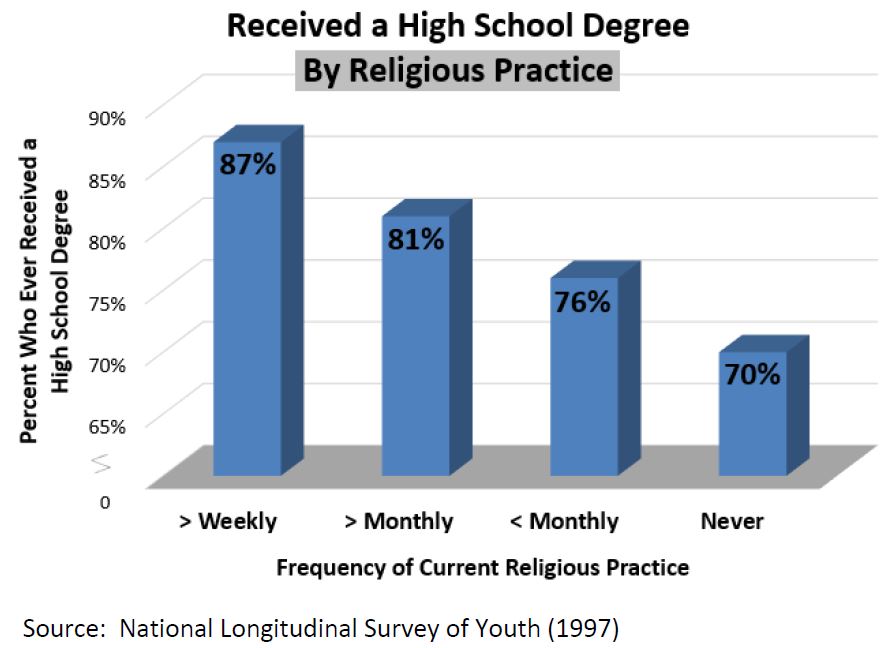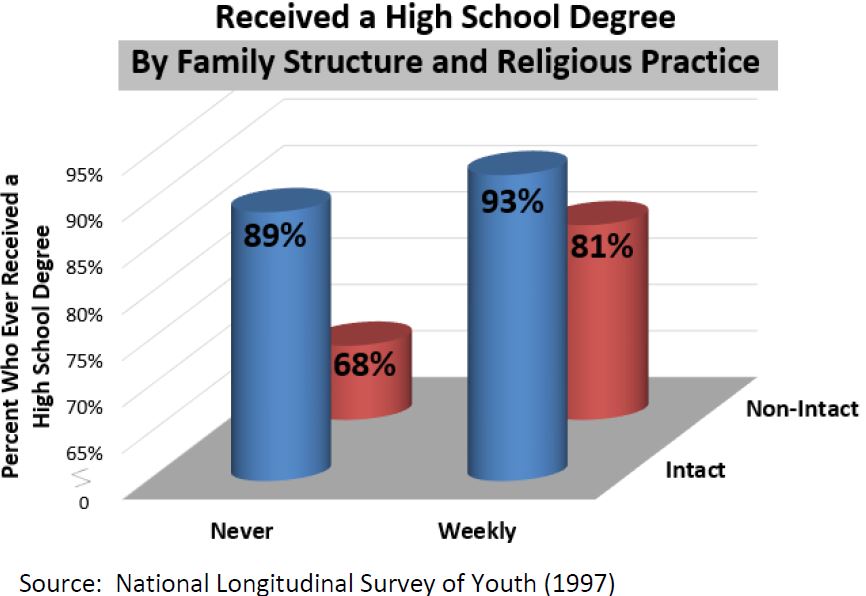Click Here to download “Received a High School Degree by Family Structure and Religious Practice”
Received a High School Degree by Family Structure and Religious Practice
The 1997 National Longitudinal Survey of Youth shows that students who worshiped at least once a week and grew up with two married parents were most likely to have received a high school degree. [1] Family Structure: Ninety one percent of individuals who grew up with married biological parents received a high school degree. They were followed by those who grew up in a married stepfamily (80 percent), those who grew up with a single, divorced parent (76 percent), those who grew up in a cohabiting stepfamily (68 percent), those who grew up with an always-single parent (63 percent), and those who grew up in an intact cohabiting family (60 percent). Religious Practice: Eighty seven percent of students who attended religious services at least weekly received a high school degree. In contrast, only 70 percent of those who never worshipped received a high school degree. Between these two extremes were those who attended at least monthly (81 percent) and those who attended less than monthly (76 percent).
Religious Practice: Eighty seven percent of students who attended religious services at least weekly received a high school degree. In contrast, only 70 percent of those who never worshipped received a high school degree. Between these two extremes were those who attended at least monthly (81 percent) and those who attended less than monthly (76 percent).
 Family Structure and Religious Practice Combined: Ninety three percent of students who grew up in intact married families and who attended weekly religious services had ever received a high school degree. Only 68 percent of students from all other family structures who never attended religious services received a high school degree. Eighty-nine percent of those who never worshipped but grew up in intact families and 81 percent of those who attended religious services weekly but came from other family structures received high school degrees.
Family Structure and Religious Practice Combined: Ninety three percent of students who grew up in intact married families and who attended weekly religious services had ever received a high school degree. Only 68 percent of students from all other family structures who never attended religious services received a high school degree. Eighty-nine percent of those who never worshipped but grew up in intact families and 81 percent of those who attended religious services weekly but came from other family structures received high school degrees.
 Related Insights from Other Studies: Nan Marie Astone and Sarah S. McLanahan, then of the University of Wisconsin at Madison, found that children from single parents and stepfamilies completed high school at lower rates than children from intact married families.[2] Another study found that two-parent families were conducive to children’s academic achievement.[3] Another study affirms the importance of religious attendance for education. One study found that the more frequently youths attended religious activities, the more likely they were to give recognition to good grades, spend more time on homework, and have a positive attitude toward academics.[4]
[1] These charts draw on data collected by the National Longitudinal Survey of Youth (1997).
[2] Astone, Nan Marie & Sarah S. McLanahan. “The Effects of Family Structure on High School Completion,” (1989).
[3] Milne, Ann M. “Family Structure and the Achievement of Children,” Education and the American Family, (1989): 32-65.
[4] Trusty, Jerry. “Relationship of High School Seniors’ Religious Perceptions and Behavior to Educational, Career, and Leisure Variables.” Counseling and Values Vol 44, No. 1 (October 1999) pp. 30-40.]]>
Related Insights from Other Studies: Nan Marie Astone and Sarah S. McLanahan, then of the University of Wisconsin at Madison, found that children from single parents and stepfamilies completed high school at lower rates than children from intact married families.[2] Another study found that two-parent families were conducive to children’s academic achievement.[3] Another study affirms the importance of religious attendance for education. One study found that the more frequently youths attended religious activities, the more likely they were to give recognition to good grades, spend more time on homework, and have a positive attitude toward academics.[4]
[1] These charts draw on data collected by the National Longitudinal Survey of Youth (1997).
[2] Astone, Nan Marie & Sarah S. McLanahan. “The Effects of Family Structure on High School Completion,” (1989).
[3] Milne, Ann M. “Family Structure and the Achievement of Children,” Education and the American Family, (1989): 32-65.
[4] Trusty, Jerry. “Relationship of High School Seniors’ Religious Perceptions and Behavior to Educational, Career, and Leisure Variables.” Counseling and Values Vol 44, No. 1 (October 1999) pp. 30-40.]]>
